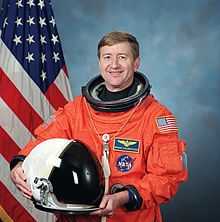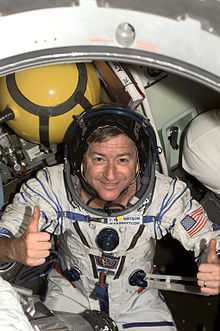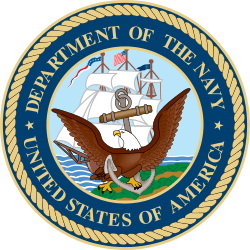Frank L. Culbertson, Jr.
| Frank L. Culbertson, Jr. | |
|---|---|
 | |
| NASA Astronaut | |
| Nationality | American |
| Status | Retired |
| Born |
May 15, 1949 Charleston, South Carolina, U.S. |
Other names | Frank Lee Culbertson, Jr. |
Other occupation | Naval aviator, test pilot |
| USNA, B.S. 1971 | |
| Rank | Captain, USN |
Time in space | 143d 14h 50m |
| Selection | 1984 NASA Group 10 |
Total EVAs | 1 |
Total EVA time | 5 hours 4 minutes[1] |
| Missions | STS-38, STS-51, STS-105, Expedition 3, STS-108 |
Mission insignia |
|
| Retirement | August 24, 2002 |
| Awards |
|
Frank Lee Culbertson, Jr. (born May 15, 1949), (Capt, USN, Ret.), is an American former naval officer and aviator, test pilot, aerospace engineer, and NASA astronaut. He served as the Commander of the International Space Station for almost four months in 2001 and was the only American not on Earth when the September 11 attacks occurred.[2] He is currently a senior vice president responsible for human spaceflight programs at Orbital Sciences, including commercial transportation to the International Space Station (ISS).
Biography
Culbertson was born on May 15, 1949, in Charleston, South Carolina, but considers Holly Hill, South Carolina to be his hometown. In June 1987, he married the former Rebecca Ellen Dora of Vincennes, Indiana. He has five children and five grandchildren.
Culbertson was a Boy Scout and earned the rank of Second Class.[3] He graduated from Holly Hill High School in 1967, and received a Bachelor of Science degree in Aerospace Engineering from the United States Naval Academy in 1971. He was a member of varsity rowing and wrestling teams at U.S. Naval Academy.
United States Navy service
Upon graduation from the U.S. Naval Academy in 1971, Culbertson served aboard the USS Fox in the Gulf of Tonkin prior to reporting to flight training in Pensacola, Florida.
After designation as a Naval Aviator at Beeville, Texas in May 1973, he flew F-4 Phantom aircraft with VF-121 at NAS Miramar, California; with VF-151 aboard the USS Midway, permanently homeported in Yokosuka, Japan; and with the U.S. Air Force in the 426th Tactical Fighter Training Squadron at Luke Air Force Base, Arizona, where he served as Weapons and Tactics Instructor. Culbertson then served as the Catapult and Arresting Gear Officer for the USS John F. Kennedy until May 1981 when he was selected to attend the U.S. Naval Test Pilot School, NAS Patuxent River, Maryland.
Following graduation with distinction in June 1982, he was assigned to the Carrier Systems Branch of the Strike Aircraft Test Directorate where he served as Program Manager for all F-4 testing and as a test pilot for automatic carrier landing system tests and carrier suitability. He was engaged in fleet replacement training in the F-14 Tomcat at VF-101, NAS Oceana, Virginia, from January 1984 until his selection for the astronaut candidate program.
He has logged over 6,000 hours flying time in 40 different types of aircraft, and has made 350 carrier landings.
NASA career
Selected as a NASA astronaut candidate in May 1984, Culbertson completed basic astronaut training in June 1985. Technical assignments since then included: member of the team that redesigned and tested the Space Shuttle nosewheel steering, tires, and brakes; member of the launch support team at Kennedy Space Center for Shuttle flights STS-61-A, STS-61-B, STS-61-C, and STS-51-L; in 1986 he worked at the NASA Headquarters Action Center in Washington, D.C., assisting with the Challenger accident investigations conducted by NASA, the Presidential Commission, and U.S. Congress.
He became lead astronaut at the Shuttle Avionics Integration Laboratory (SAIL); lead of the First Emergency Egress Team; and lead spacecraft communicator (CAPCOM) in the Mission Control Center for seven missions (STS-27, STS-29, STS-30, STS-28, STS-34, STS-33, and STS-32 [note that Shuttle missions are not ordered chronologically]). Following his first flight, he served as the Deputy Chief of the Flight Crew Operations Space Station Support Office, as well as the lead astronaut for Space Station Safety. He was also a member of the team evaluating the hardware and procedures for the proposed mission to dock with the Russian Space Station Mir. Following STS-51, Culbertson was Chief of the Astronaut Office Mission Support Branch; then Chief of the Johnson Space Center Russian Projects Office. In 1994, Culbertson was named Deputy Program Manager, Phase 1 Shuttle-Mir, and in 1995 became Manager of the Shuttle-Mir Program. He was responsible for a multi-national team which executed nine Shuttle docking missions to the Russian Space Station Mir, with seven astronauts spending 30 months cumulatively on board the Mir Station, plus all the associated science and docking hardware to ensure the success of the joint program, a precursor to the building of the joint International Space Station. Just prior to his current flight assignment, Culbertson spent one year as Deputy Program Manager for Operations of the International Space Station Program.
Spaceflight experience

A veteran of three space flights, Culbertson has logged over 146 days in space .
STS-38 Atlantis (November 15–20, 1990) was a five-day mission during which the crew conducted Department of Defense operations. The mission concluded after 80 orbits of the Earth in 117 hours, 54 minutes, 28 seconds, the first Shuttle to land in Florida since 1985.
STS-51 Discovery (September 12–22, 1993) was a ten-day mission during which the crew deployed the U.S. Advanced Communications Technology Satellite (ACTS/TOS), and the Shuttle Pallet Satellite (ORFEUS/SPAS) carrying U.S. and German scientific experiments, including an ultraviolet spectrometer. A seven-hour EVA was also conducted to evaluate Hubble Space Telescope repair tools and methods. After the SPAS spacecraft had completed six days of free flight some 40 miles from Discovery, the crew completed a successful rendezvous and recovered the SPAS with the Shuttle's robot arm. The mission concluded with the first night landing of the Shuttle at the Kennedy Space Center. Mission duration was 158 Earth orbits in 236 hours and 11 minutes.
The Expedition 3 crew launched on August 10, 2001 aboard STS-105 Discovery and docked with the International Space Station on August 12, 2001. Culbertson lived and worked aboard the station for a total of 129 days, and was in command of the station for 117 days. He was the only American not to be on Earth during the September 11 attacks.[4] As the ISS passed over the New York City area after the attacks, Culbertson took photographs of the smoke emanating from Ground Zero in lower Manhattan.[5][6] He later learned that the plane that struck the Pentagon had been piloted (at takeoff) by his Naval Academy classmate Charles Burlingame. The Expedition 3 crew left the station on December 15 aboard STS-108 Endeavour, landing at Kennedy Space Center, Florida, on December 17, 2001.
Organizations
He is a member of a number of organisations, including the American Institute of Aeronautics and Astronautics (senior fellow), the Association of Naval Aviators, the Aircraft Owners & Pilots Association, the Aviation Boatswains Mates Association, and the Association of Space Explorers.
Awards and honors
Culbertson has received numerous awards, including the Legion of Merit, the Distinguished Flying Cross, the Defense Superior Service Medal, the NASA Outstanding Leadership Medal, NASA Space Flight Medals, Navy Commendation Medal, Air Force Commendation Medal, the Armed Forces Expeditionary Medal, the Humanitarian Service Medal, and various other unit and service awards. Distinguished graduate, U.S. Naval Test Pilot School. He has been awarded Honorary Doctor of Science Degrees from the College of Charleston, 1994, and Lander University, 1999; he has also been awarded the Komarov Certificate for Space Flight Achievement, 1994, the AAS Flight Achievement Award for STS-51, 1994, Aviation Week & Space Technology 1997 Laurel for Achievement in Space, IEEE/ASME Award for Manager of the Year, 1997, and the Space Center Rotary Club Stellar Award for 1998.
References
![]() This article incorporates public domain material from websites or documents of the National Aeronautics and Space Administration.
This article incorporates public domain material from websites or documents of the National Aeronautics and Space Administration.
- ↑ Frank L. Culbertson's EVA experience
- ↑ msnbc.msn.com
- ↑ Frank L. Culbertson, Jr. at scouting.org
- ↑ Greene, Nick. "September 11, 2001 Terrorist Attacks - 9/11 Attacks" About.com:Space/Astronomy.
- ↑ news.blogs.cnn.com, 2011/09/09.
- ↑ Jones, Jonathan, "The 9/11 attack seen from space – an image of impotence", The Guardian, 10 March 2014. Retrieved 2014-03-16.
External links
| Wikimedia Commons has media related to Frank L. Culbertson, Jr.. |
- Culbertson's official NASA biography
- Astronautix biography of Frank L. Culbertson, Jr.
- Spacefacts biography of Frank L. Culbertson, Jr.
- Culbertson at Spaceacts
| ||||||||||||||||||||
